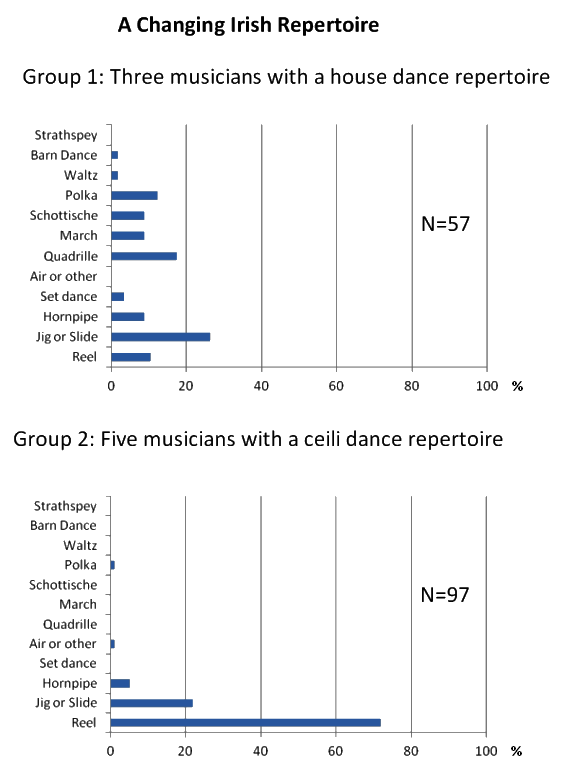
As we saw in Chapter 6, ballroom-style round dances and quadrilles were scorned as 'foreign' and house dances were effectively banned by Irish clerical and nationalist leaders in the early twentieth century, during the country's struggle for independence and its early years as an independent State. Just as the Gaelic League sought to reinstitute the Gaelic language, that organization and others sought to promote more purely Irish music and dance, and this goal had widespread public support. Eighteenth century reels were brought back from a general decline and put to use in the figure dances of the Gaelic League. The céilí dances required a new Irish repertoire, long on reels, jigs and hornpipes, with effectively none of the old schottisches, barn dances, mazurkas and varsovianas, and a greatly reduced numbers of polkas and waltzes.
With the beginning of these 'more-Irish' céilí dances and the departure of the old house dance repertoire, usage of concertinas was to fall precipitously; the new parish dance halls required bands, not solo concertina or fiddle players as in the old house dances. Some players simply stopped playing as the older dance styles receded, and many others fully embraced a new Irish repertoire. As a result, recordings of concertina players of the house dance era in Ireland, when ballroom-style dances were king, are scarce indeed, despite the incontrovertible evidence that such dancing in country houses was the most popular form of entertainment in the late nineteenth century, from the Gaeltacht to the Pale.
The concertina players represented in this archive lived through this tumultuous period of cultural change, and may be separated into two general groups. A first group contains musicians whose recordings reflect the classic house dance repertoire, where an evening's fun would contain primarily round dances and quadrilles as well as some reels and jigs. All but one of the musicians in this first group are women. Two of them (Mary Ann Carolan and Ella Mae O'Dwyer) more or less stopped playing as the house dance era declined, and were recorded late in life; of a third (Katey Hourican) less is known. There is little doubt that the cessation of playing allowed those women to retain their early repertoire in a way that active, continued playing in an era of rapid changes in repertoire - from céilí dances to pub sessions to folk revival - would not. A fourth, Terry Teahan, emigrated to the United States in the late 1920s. After finding his footing in the New World, he resumed playing about 15 years later, playing for the set and round dances that had by that time been discouraged and banned back in Ireland.
A second group of musicians, although of the same generation, left behind recordings that are almost entirely in the style of the céilí dance era, consisting nearly entirely of reels and jigs, with lesser numbers of airs and hornpipes. All but one of these musicians were men. Some had actively supported their country's struggle for independence (Michael Doyle of Clare, for example, was a member of the early IRA), and the effort to regenerate a more Irish music and dance requested by the Gaelic League and later Comhaltas Ceoltóirí Éireann came naturally to them. The one woman among this group, Elizabeth Crotty, was an officer of the CCÉ and its first president for life, and no matter what types of dances had been popular in her youth, her apparent choice was to play an 'Irish' repertoire. Other members of this second group include William Mullaly of Westmeath, who recorded in the 1920s, as well as Patrick Flanagan and Tom Barry of Clare.

A comparison of dance types in the repertoire of group 1 (house dance repertoire) with group 2
(céilí dance repertoire). Tune counts (shown in percentages of total) include those of all known
recordings for each individual, and include a total of 57 separate tunes from group 1,
and 97 from group 2.The second group has narrowed its focus greatly on reels and jigs.
Group 1: Mary Ann Carolan, Ella Mae O'Dwyer; Katey Hourican.
Group 2: William Mullaly; Patrick Flanagan; Tom Barry; Elizabeth Crotty; Michael Doyle.
The differences of the tune choices of the individuals in these two groups is striking. In the above chart, the known repertoire of the three women of group 1, consisting of some 57 tunes, is classified by dance type and compared to those of the second group, with some 97 known recorded tunes. The much narrower repertoire of the latter group, dominated by reels, is clear. In the céilí dance era, the reel was king in Irish music, and still is today. The mix of ballroom dance styles in the music of the former group, however, closely resembles that used by concertina players of similar vintage recorded in Australia, England and South Africa, with the exception of double reels and hornpipes. Yet the individuals in both groups belong to the same generation; all were born between 1885 and 1906.
A third group of three musicians in this archive left behind so few recorded tunes that their position with respect to the great change in repertoire is not fully known. A recording made by Ciarán Mac Mathúna of RTÉ in 1956 of Clare musician Jim Droney includes only a reel and a jig, but the repertoire of his son Chris, who learned most of his early music from his father, is rich in polkas, waltzes, and marches, as well as reels and jigs; all were used in old-time house dances. Stack Ryan, also of Clare, is a legendary player of the house dance era, but the only publicly available tune of his that remains is an air. However, the tunes he passed on to those pupils who learned from him, in particular Bernard O'Sullivan, included numerous polkas, waltzes and marches from the old house dance repertoire. Martin Howley of remote Fanore, County Clare, was a traditional singer who lived a quiet rural life and left only a very few concertina tunes, among them an archaic jig played on an equally archaic German concertina. It is impossible to know or even guess the range of his repertoire.
Another woman with a multi-decade interruption in her playing career was Margaret Dooley of Knockjames, a townland near Tulla in East Clare. Born in 1884, she was interviewed by Gearóid Ó hAllmhuráin in 1985 at the age of 101 years. She played for house dances in her youth, like the one that she spoke of in the quote that began Chapter 6. She reportedly stopped playing in the second decade of the twentieth century, which coincidentally was the time of the anti-foreign music crusades and the beginning of the end of house dances. She did not play again until 98 years of age when given a concertina by a relative in America. Her resurrected repertoire was very like that of Carolan, O'Dwyer, and Hourican: polkas, flings/schottisches, and mazurkas mixed in with jigs, reels and hornpipes. Like them, she played in a simple fashion, mostly in the key of C, with a rhythm designed for the needs of dancers. According to Ó hAllmhuráin, she knew that 'traditional' music had changed enormously since her youth. Certainly she knew that it had grown more complex, saying:
The earlier days of ballroom dance styles at house dances were recalled by the late Tommy McCarthy (1939-2002), who recalled of his youth in Clare that:
Polkas, and all the other dances of the ballroom genre, were easier to play than reels even when played rapidly because most of them had been composed on the concertinas and accordions.
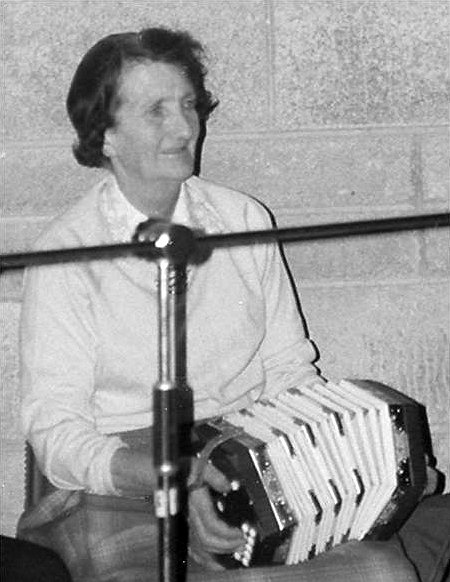
Mary Ann Carolan (1902-1985) holding her German concertina
at the Drogheda Folk Festival, c.1977.
Photograph by Joe Dowdall, courtesy of the Irish Traditional Music Archive.
Music and dance were a common occurrence at her childhood home in Tenure. As she put it in a 1985 RTÉ interview:
Her song repertoire contains a strong Scottish influence, as well as a number of songs written by an earlier Drogheda songwriter named John Shiels. She also had some American minstrel songs, one in particular being Young Bob Ridley that exists today in America only in archived nineteenth century broadsheets, but that lived on in the rural County Louth singing tradition.
Her concertina repertoire strongly reflects the house dance tradition. This mixture of quadrilles, waltzes, polkas, and marches indicate a thriving ballroom dance component to the house dances in her home. At the same time, she recorded several reels and jigs that reflected a strong traditional component to her repertoire, just as existed in her repertoire of songs. She tended to play reels singly rather than in octaves, very probably because of their rapid tempo.
She recorded a number of what she called 'quadrille tunes', among them a medley of slides, The Lass Of Gowrie, Untitled, and Try And Help Him If You Can. The slides are played all on the C row and mostly in octaves on her C/G German concertina, as is the polka The Lass of Gowrie. But the next two polkas in the medley of polkas, although in also the key of C and mostly played in octaves, spread to both rows of the concertina - especially the last tune, which is higher-pitched and is played mainly on the G row. Both medleys were recorded in 1985 and released in the program The Long Note, and appear courtesy of RTÉ, Ireland's Public Service Broadcaster.
The following six recordings were made of Carolan's playing in the 1980s, by Jim MacArdle of Tallanstown, County Louth, who has kindly made them available.
A schottische/fling, Lady Mary Ramsay, is also played in octaves, and all on the C row. Like some of her traditional songs, it shows a Scottish influence in her repertoire.
She recorded several marches, of which one, Napoleon's March, is included here. Marches were commonly used as 'curtain raisers' in old time house dances to begin to form up sets for quadrilles. Like the above tunes, it is played in C on the C row, in octaves.
The Veleta Waltz was a ballroom sequence dance that was introduced in 1900, shortly before Mrs Carolan was born. The tune she plays for it is in C, played all on the C row.
Bonnie Kate is an example of one of her reels, which she plays mostly singly (one note at a time rather than in octaves), because of the rapid tempo. Playing reels singly is typical of all recorded old time players in Ireland.
Quadrille #3 is a single reel used for sets. She plays it mostly singly. The A part is in C and played all on the C row, and the B part is in G and played on the G row.
You're Welcome Home Prince Charlie is an example of one of Carolan's jigs. Like most of her other tunes, it is played on the C row, in C, and in mostly in octaves.
Mrs Carolan played a C/G German concertina that had double banks of reeds tuned an octave apart, which meant that when playing in octaves she was sounding four reeds for each melody note, which gave a full, accordion-like sound. In a 1985 RTÉ interview she makes it quite clear that volume (one of the benefits of octave playing) was an important part of her dance music. When asked about the demise of the concertina in the middle and late twentieth century, Carolan said, "It has died out. There are better instruments - louder. Louder instruments." As music moved from house dances to the new public halls, the concertina faded before the much louder accordion.
I was at the door, at the age of 6, collecting the 4 pences (approx. 4 cents later). One night a man from Kerry, seeing that I was so small, passed me in without paying. He went over to the right and sat down. Off I went after him looking for my four pence. I stayed at him for about 20 minutes until I got the four pence off him ... but by then about half the hall had got in for nothing! When I was 8 years old, I went up on the stage playing the accordion with my mother, and my father went on the door collecting the four pences.
Bit by bit the remaining members of the family joined in the band: Norelene on piano, Liam on the piano accordion and drums, Maura on piano and cordovox, and Sean on drum and vocals, and guitar and trumpet in the 1960s ...![]() 7
7
For a good while, the Parish Priest (to put it mildly) was not favourably disposed towards the dances as he looked on them as "occasions of sin". He would ask people in Confession if they were dancing in our hall the Sunday night before. On occasions he would walk into the hall, spread out his hands in a gesture that would say "All out" to those who would go out for him. At the time many people used be walking up and down the road in front of the hall afraid to go in. It wasn't until my father, cycling to Castletownbere one day, stopped the Parish Priest on the road and said to him: "May God forgive you, Father. You are taking the bread and butter out of the mouths of my children", that this nonsense stopped.
Despite what was done to them as regards the dance hall in the early years, my father and mother, who were deeply religious, kept the Faith and attended Mass regularly... 'Tis strange how the ways of the world change. The dance hall, which in early years had come under considerable opposition from the then Parish Priest, came in handy in 1994/1995, as Masses were held there while the Ardgroom Church was being renovated.![]() 8
8
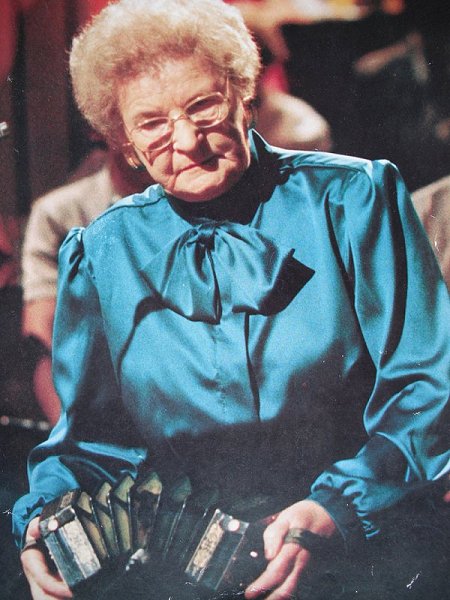
Ella Mae O'Dwyer
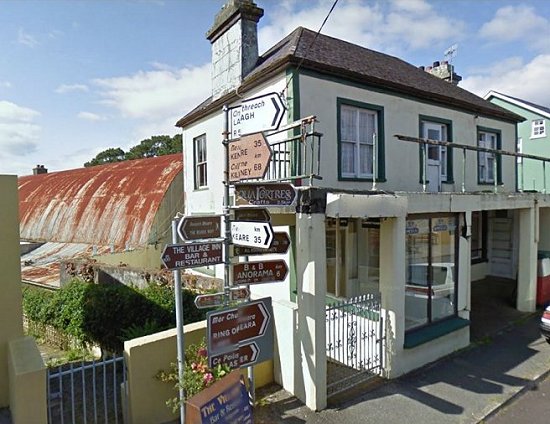
The O'Dwyer's former dance hall is the building with the rounded tin roof,
which is behind the O'Dwyer family home in Ardgroom (2011).
Mary O'Sullivan, who lives in Ardgroom, recalled the dancing of sets there well into the 1940s:
Dancing the Ardgroom Set in the O'Dwyers' dance hall, 1960s. Courtesy Sean O'Dwyer
In 1974, Mrs O'Dwyer was recorded by Neil Wayne and John Tams on their recording trip to the west of Ireland. She was the oldest and also the only woman of their sources on that trip, and stands out in that group with her use of the German concertina. The following three tunes were recorded at that time and appeared in the CD Irish Traditional Concertina Styles (re-released in 2007). They appear here courtesy of Neil Wayne and Free Reed Records.
Mrs O'Dwyer's Fancy is a set of polkas that were used in the set dances at Ardgroom. She plays this tune in the key of F on her Bb/F concertina. She starts the tune on the lower row (F), then moves up to the upper (Bb) row, and then weaves the tune back and forth the two rows. Every convenient note is played in octaves; only the quicker or inconvenient parts are played singly.
That driving, heavily cross-row octave style is also evident in The Ardgroom Set, which also consists of polkas (known as Johnny Leary's Polka and Tournmore, or Wallace's Cross, according to Gearóid Ó hAllmhuráin).
The Stack of Barley, a hornpipe presented as a barn dance in her 1974 recording, is played very rapidly, and for the most part, singly.
Mrs O'Dwyer was also recorded by Séamus MacMathúna in the 1970s. The following two tunes are from that session, and appear courtesy of RTÉ, Ireland's Public Service Broadcaster.
Old Set Tunes include a set of slides. They are played largely singly with octaves and drone notes interjected occasionally.
An Untitled march is played partly in octaves, and partly singly, as fits each phrase.
Ella Mae O'Dwyer's Ceilí Band concertina, made in Germany.
It is double reeded, with two sets of reeds tuned an octave apart.
With thanks to Maura and Sean O'Dwyer.
Mrs Hourican recorded 11 tunes. Of them, five were flings (schottisches), two were polkas, two were jigs, and two were reels. Her repertoire reflects the house dance days, and her playing style is not unlike that of Mary Ann Carolan or of Ella Mae O'Dwyer. Her tunes appear here courtesy of Comhaltas Ceoltóirí Éireann.
She plays a German concertina keyed in C/G. Spanish Lady, a song/polka, is played in G, using octaves nearly throughout; she plays across the two rows.
An Untitled polka is similarly played, with a few bass chord notes occasionally injected amongst the low octave notes of the left hand.
Like Carolan and O'Dwyer, she plays with a drive and sparseness that suggests a history of playing for dances. Two flings (schottisches), Mammy Will you Buy Me a Bow Wow, are played at a relaxed tempo, with lower octaves and partial bass chords added intermittently to enhance the beat. The latter tune is a version of The Keel Row, as the tune is generally known. O'Dwyer's title for it is a mnemonic device that recalls the first notes of the tune.
A reel, The Merry Blacksmith, is played mostly singly, along the G row, in the A part, with left hand octave notes added occasionally for emphasis. The B part is played mostly in octaves.

Terry 'Cuz' Teahan, as seen in the insert of the 1977
Topic LP Old Time Irish Music in America.
Photo by Mick Maloney.
Although mainly remembered as a button accordion player, the German concertina was his first instrument, and he continued to play it throughout his life. He was eight when he started playing the concertina, getting a first lesson from the great Sliabh Luachra fiddler Padraig O'Keefe, who at that time also played the concertina. At the age of ten, Teahan first received his own concertina. After that instrument was accidentally dropped into a stream by a girl to whom he had lent it, he played the concertina at a neighbor's farm instead. For a while he stopped playing, and by the time he was 15 or 16, he became actively involved in crossroads dancing:
Usually there would be four fellows standing in one line to finish and then four others to get started. Usually you never had the same kind of dancing. If one crowd danced The High Caul Cap, that tune would be played all the way through. And the next crowd would dance Hurry the Jug, and that tune would be played all the way through. Another crowd might dance The Jenny Lind which was five complete figures...
An IRA ambush of British soldiers in Castleisland in 1921, where a number on both sides were killed only hours before a general truce was called, left a deep impression on Teahan. He wrote a tune about the skirmish, and stopped playing for nearly twenty years, until about 1940. Teahan emigrated to Chicago Illinois in 1928, and lived there for the next six decades until his death in 1989. In the 1940s he began playing for Irish dances in Chicago, playing into the early 1960s. He recalled that these dances included set dances, the Stack of Barley, the Highland fling, the varsoviana, and the barn dance: all staples of the old house dances in Ireland that continued to thrive among immigrants. After another playing hiatus, he began playing again in the 1970s, during the revival of Irish music in America.
Although mostly a button accordion player, he also played the fiddle and the concertina. Two recordings included here were recorded in the 1970s and are taken from a Topic LP of 1977 entitled Old Time Irish Music in America produced by Mick Maloney. They are included with permission of Topic Records Ltd. His recorded repertoire on that LP consists of four polkas, seven slides, one barn dance, two flings/schottisches, three hornpipes, a waltz and an air: a mix of tunes not unlike that of the three women discussed above. Three of these recordings were on a concertina.
Teahan played a German concertina not unlike those owned by Carolan, O'Dwyer and Hourican. Poll Ha'Penny is a fling/schottische, also played in C and entirely on the C row.
In the liner notes of the 1977 LP, Mick Maloney observed of Teahan's playing and that of Gene Kelly (another accordionist on that LP):
The following two musicians, Stack Ryan and Jim Droney, left behind few recordings, but a fair amount is known from them by way of their pupils (in the case of Stack Ryan) and descendants (in the case of Jim Droney). On that basis, they are here tentatively grouped with the house dance players. Finally, the late Martin Howley, a traditional singer who also played concertina, left only a few recordings of concertina tunes; these are jigs and a polka. It is difficult to even guess the broad thrust of his repertoire, and he is included in this section by default.
He'd disappear outside you know and myself and Solus would be gigglin' inside and plain' any old thing at all you know and we'd be playin' it and one of us would say, "Is that good enough?" "Ah, 'tis good enough." Next thing Stack would call in, he'd open the door and he'd come in and say, "You played a wrong note there, I was listenin' to you outside." ...'Twas good fun.
He was a real lovely man you know. If he was around today I don't know how you would describe him....He was a farmer and never went very far away, only around the country house dances. He had great ould tunes. He used to play a lot of slides and Kerry music. Bernard O'Sullivan back here in West Clare would be maybe the only one who continued on the way he used to play.
The music played by Stack Ryan and his equals would not be anywhere near as intricate as it is now, but 'twas correct music and nice for dancin'.![]() 10
10
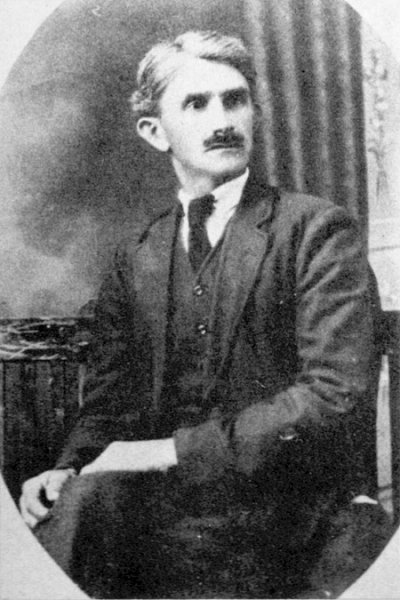
Stack Ryan as a young man.
Photo courtesy Neil Wayne and Free Reed records.
Ryan was recorded by Ciarán Mac Mathúna of RTÉ in the 1950s. Only one tune of these recordings is publically available, although there may be more in the vaults of RTÉ in Dublin. This recording is the air Eamonn a' Chnoic, which appears in this archive courtesy RTÉ, Ireland's Public Service Broadcaster. Ryan plays it on an Anglo concertina pitched in C/G, and the tune is remarkable for its abundant simplicity and quiet dignity. It is played part singly, and part in octaves, without a single ornament. It is remarkable to consider the difference in how that tune might be played by concertina players of today, with ornaments hung on every bough.
As Tommy McCarthy mentioned (above), the player of modern times who best carried on the legacy of Stack Ryan was the late Bernard O'Sullivan (d.2006) of Cooraclare, County Clare. Of his own playing, O'Sulllivan commented to Muiris O Rócháin that:
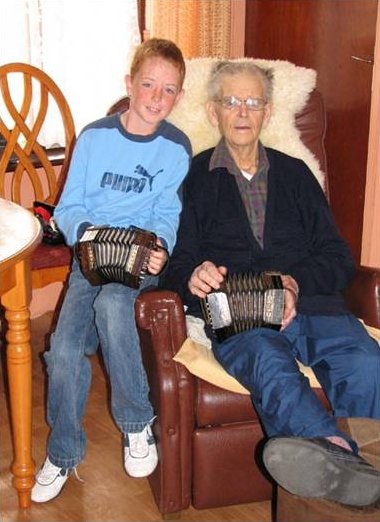
The late Bernard O'Sullivan with his grandson, 2006.
Photo courtesy of Shay Fogarty.
Three tunes from Bernard O'Sullivan, all of them thought to be connected with Stack Ryan, are included in this archive. They are from the 1974 CD entitled Tommy McMahon & Bernard O'Sullivan, Irish Traditional Music of County Clare (re-released in 2007), and are included here courtesy of Neil Wayne and Free Reed Records. Two of the tracks are polkas, and one a waltz; all feature octave style playing.
Stack Ryan's Polka is played in C, with all four of its parts played exclusively on the C row. Octaves are used extensively throughout the piece, in some places used sparingly for rhythmic emphasis, and in other places used on nearly every note.
Another polka, I have a Bonnet Trimmed with Blue, is played with O'Sullivan's friend and neighbor, the younger player Tommy McMahon. A transcription of their playing of it is included below. It is played in the key of G on a C/G concertina, and is played nearly completely in octaves in a cross-row style. The first four notes, in a low part of the scale, are played on the C row, and the next four notes, which rise in pitch, are played on the G row; the rest of the tune bounces back and forth from one row to the other. Two-row octave playing is a powerful technique, not only for volume but for its ease of playing and the accuracy it imparts; one can play in this manner with great intuitive confidence, and it is perfect for dancing. Stylistically, O'Sullivan's playing (and presumably that of his mentor Ryan) is very, very close to Australian player Dooley Chapman; both have a sparse, extensively octave two row style, and beyond the obvious issue of repertoire it would be difficult to separate them in an audio line-up.
The second tune of that medley, The Rakes of Mallow, is variously referred to as a polka or a single reel.

I Have a Bonnet Trimmed With Blue, as played by Bernard O'Sullivan and Tommy McMahon.
Transcribed for the C/G Anglo by Dan Worrall
A waltz medley, My Heart Is in the Highlands, and The Dew Drop, is also played by O'Sullivan in tandem with Tommy McMahon. These tunes are played on Bb/F instruments, with the first tune in the key of Bb, and the second in F. Highlands starts singly, with the left hand octaves added only for occasional emphasis, but the B part is played solidly in octaves, as is the entire second tune. All three of these tracks from Bernard O'Sullivan and Tommy McMahon are clean, simple and graceful expressions of the old octave style once so prevalent in Irish playing.
Jim Droney had five sons, and although several could play concertina, it was his son Chris Droney (b. 1925) who excelled, carefully learning much of the repertoire of his father. He was interviewed by American concertina player Joseph Green, in 1994:
They had no radio, no television, nothing in them times, do you see? What they used to do, they'd visit each other. Visit the houses in the locality. And they'd no transport, nothing. But wherever you went, you'd walk. So it meant that in a village, if there was five or six or eight houses in the village, they'd visit you tonight, and then they'd all be visiting me the night after, and then they might be visiting the next neighbor the night after that, and they'd keep going in rotation like that. And they used to have a concertina for a few pounds, and learned how to play it.![]() 13
13
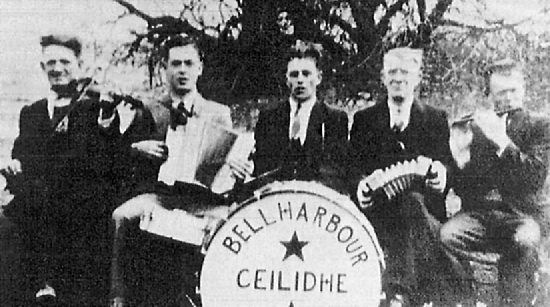
The Bell Harbour Ceilidhe Band, 1946. Chris Droney holds an accordion,
and his father, Jim Droney plays the concertina.
From Joseph Green, 'A Conversation with Chris Droney' in 'Concertina and Squeezebox', 1995.
The Droney family home, Bell Harbour House, was a popular meeting place for these house dances, and the annual Wren dance was usually held there. The Droneys played reels and polkas for set dances, along with jigs, hornpipes, marches, waltzes, and airs. By the late 1930s, the house dances had mostly declined, and new halls for dancing were springing up. In north Clare the old sets and waltzes continued, regardless of the desires of the Irish Dancing Commission in faraway Dublin. Chris Droney told of playing at a local hall in Kinvara for his first paid performances as a dance musician:
Now some of these new players - I don't know, maybe I'm wrong, but I don't like that style of playing. If you put eight people dancing a Caledonian set, and put one of these lads playing the tunes, they won't dance. I've seen it happen ... These new players, they have a different style. A different style altogether. Great for concertinas, great for records, great for entertainment, but if you put eight good dancers up on the floor, they won't dance the set.![]() 15
15
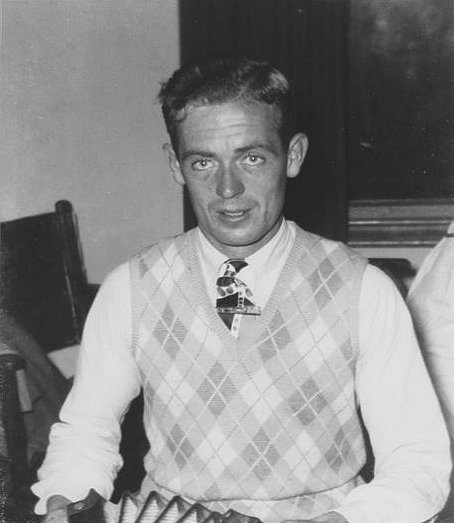
Chris Droney with concertina, ca.1948.
Courtesy the Irish Traditional Music Archive, Dublin.
An Untitled reel was recorded by Jim Droney at that 1956 recording session. The piece is played in a rapid, driving manner in the key of G on a C/G instrument, but is played mostly (perhaps entirely) on the C row. The A part is played singly, but with a rhythmic pulse added of left hand partial chords. The B part is played mostly in octaves, again on the C row. The recording is courtesy of RTÉ, Ireland's Public Service Broadcaster.
Paddy O'Rafferty is a jig, recorded in 1956 of Jim and Chris Droney playing together. It is played in G, entirely on the G row, and nearly entirely in octaves. It has a great driving tempo that shows the tremendous skill of the two players. The recording is courtesy of RTÉ, Ireland's Public Service Broadcaster.
The two also recorded another jig, the Three Little Drummers (also known as The Rambles of Kitty) in that 1956 session. Chris Droney plays the same tune, solo, on the 1974 CD The Flowing Tide. The recording of this latter version is of an improved quality, and perhaps better for studying the style of the piece, although the version of the two together has a driving force that is undeniable. The tune is played in G, mostly in octaves, and all on the G row. All but one highly pitched phrase (in the A part) is played in octaves. The recording is courtesy of RTÉ, Ireland's Public Service Broadcaster.
Gearóid Ó hAllmhuráin interviewed the Droney family, including Chris's daughter Ann and son Francis, in 1986, and was impressed by the uniformity of melody, variation, phrasing and rhythm of Ann's and her brother Francis's playing as compared with that of their father; clearly this is music that is being faithfully passed down from generation to generation. Francis spoke of learning from her grandfather, Jim Droney:

Martin Howley as a young man, with melodeon.
With thanks to Joe Queally and Jim Carroll.
It is difficult to ascertain the precise pitch of Martin Howley's instrument from the recordings; it may be that the old tape used has wobbled in pitch , or that his instrument had an unusual old pitch. What would be concert C on a C/G concertina is approximately B# on the recording. In this discussion, we will assume that it was a C/G concertina.
The version of Maggie in the Wood, a polka, that Howley plays is very simple, as befits its likely origins as a concertina tune. It is played in C, all on the C row, and almost all in octaves. He plays several variations on this very common tune which give it an archaic, yet somehow fresh sound. He taps time carefully and audibly with his feet as he plays.
Bothar na Sop. He also plays what he calls a "very old" jig, giving it a title in Irish that means the "Straw Road.". He plays it in the key of G, all on the G row. The first part is played singly, and the second part nearly all in octaves.
Finally, he plays a very archaic-sounding Untitled Jig in Dm, playing it all on the C row, much of it in octaves.
Such emigrated music soon returned in the form of gramophone records of such émigré musicians as Michael Coleman and Paddy Morrison, and in printed form with the collections of Francis O'Neill. Disregarding for the moment some local deep wells of folklore, an entire generation of Irish musicians relearned an earlier pre-Famine repertoire from such materials. For example, Paddy Murphy the late, well-known player from the Connoly/Kilmaley area, remembered how he and his friends learned new tunes from local postman Hughdie Doohan, a fiddle player who could read music and owned O'Neill's The Dance Music of Ireland. Said Paddy:
She had a wide exposure to Irish traditional music. Because of poor health, she occasionally travelled to Dublin for treatment, and met many musicians there as well as attended Oireachtas competitions. When a branch of the Comhaltas Ceoltóirí Éireann was started in Clare, she became a founding member, and later became its first president for life. She played music regularly at the family's pub, meeting many visiting musicians, and was recorded on several occasions in the 1950s by Ciarán Mac Mathúna of RTÉ. Partly because of the national exposure these recordings, and the broadcasts of them, brought, she was a much-respected celebrity within the traditional music community.

Elizabeth Crotty and Kathleen Harrington. Photo courtesy Michael Tubridy.
Her birth year, 1885, places her well within the generations that experienced the old house dances, and yet her recorded repertoire reflects very little of it. We know that others in her area, such as Stack Ryan and his musical descendants, Solus Lillis and Bernard O'Sullivan, played many polkas and slides for set dances, as well as waltzes and marches. Her area is just across the Shannon estuary from Kerry, where such music was and is common. And yet her recorded repertoire (as evidenced from the CD produced of her music from the RTÉ recordings of the 1950s) consisted primarily of reels (72%), jigs but not slides (17%), hornpipes (8%) and a single polka. If we compare her repertoire to that depicted in the chart shown at the beginning of Chapter 6, which compared the concertina repertoires of three women of the house dance era with three modern women, Mrs Crotty clearly resembles the latter rather than the former. As Fred McCormick pointed out in a review of that CD at Musical Traditions in 2000:
But the reels! She was a master player. An audio file of a classic medley of hers, The Wind that Shakes the Barley and The Reel with the Beryl, is included here. It is reproduced from a 1950s recording made by Ciarán Mac Mathúna, courtesy RTÉ, Ireland's Public Service Broadcaster.
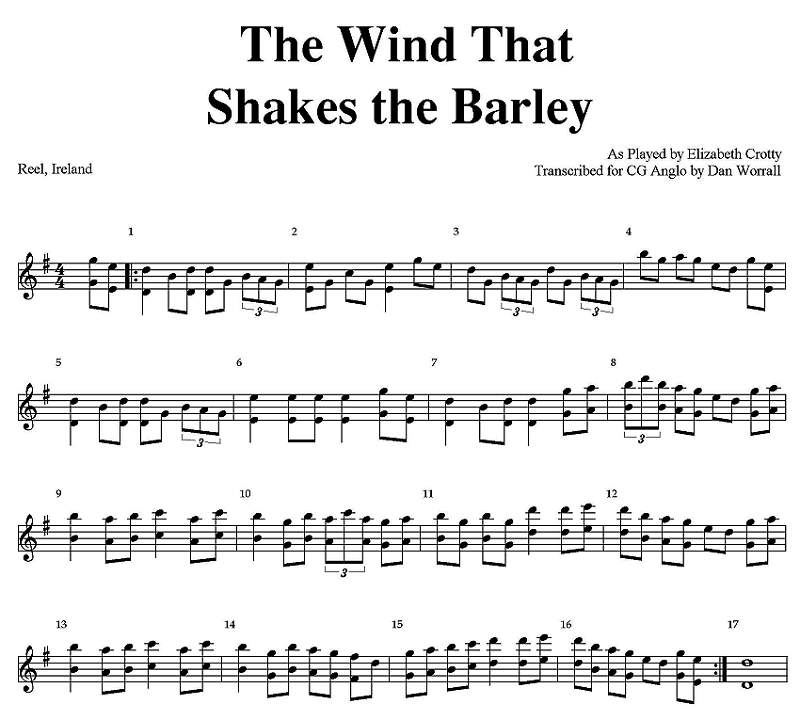
The Wind That Shakes the Barley, as played by Elizabeth Crotty. Transcribed for the C/G Anglo by Dan Worrall
A close look at The Wind that Shakes the Barley reveals much about both her background and the way in which the old German concertina shaped the way in which a musician played. Although the tune is recorded on the reasonably high quality Lachenal Anglo concertina pitched in C/G that Mrs Crotty played in her later life, she spent her early playing years playing the much less expensive German concertina. If that earlier German concertina was like those played by Ella Mae O'Dwyer, Katey Hourican and Mary Ann Carolan on their recordings in this archive, it was one made with a double bank of reeds; for every button pushed, two reeds sounded that were pitched an octave apart. This gave the instrument a much-desired accordion-like sound, and more volume. C/G German concertinas (such as Carolan's) had a deep baritone sound, because the second bank of reeds was tuned an octave below the 'normal' ones.
The inexpensive, mass-produced German concertina was never particularly efficient in its use of air, but playing quick tempo reels on the large double-reeded ones was a bit like running through mud. You could do it, but not as easily as you might have wished. Recordings of Michael Doyle of Ballymakea Mullagh, County Clare (see below) were on such an instrument, and in one recording after a particularly vigorous passage, he groans with the exertion.
The standard version of The Wind that Shakes the Barley, it could be said, is the one in O'Neill's Music of Ireland, where it was transcribed from the playing of Chief O'Neill himself, who played the flute. The reel was imported to Ireland from France around the mid-eighteenth century, and the instruments that were in use in Ireland at that time were the pipes, fiddle and flute. Accordingly, most of the pre-Famine reel repertoire was composed on these instruments. What is easy for the flute or the pipes, however, is not necessarily what is easy on the German concertina.
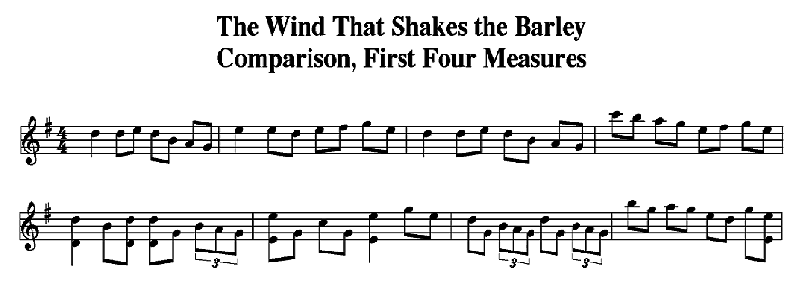
A comparison of the first four bars of 'The Wind That Shakes the Barley',
between that of Francis O'Neill, top (originally in D), and Mrs Crotty, bottom.
The adjacent illustration compares O'Neill's version (top) with Mrs Crotty's (bottom). O'Neill's version was originally written in the key of D, and has been changed to G - the key Mrs Crotty plays it in - for the purposes of this comparison. The O'Neill version contains numerous brief scale runs, which are simplicity itself to play on the flute. On a two row German concertina when played along the rows, easy on the flute but less so on the German concertina. Each one step advance up or down the scale requires a change in bellows direction, in effect requiring the musician to switch the bellows direction back and forth, opening and closing. Given the inefficient nature of the German concertina's bellows, this can be difficult at the rapid tempo desired. No matter that a player like Chris Droney with a high quality Wheatstone Anglo could drive right through such passages with no bother; the German concertina is less efficient and thus more difficult to play. And no matter that Mrs Crotty herself recorded this piece late in life on a higher quality Lachenal Anglo, and could herself manage the passage without difficulty. Her early experience playing the German concertina has apparently shaped her style in playing the tune.
Mrs Crotty replaced most of those scale runs with interval jumps of varying width. These jumps require fewer direction changes and are hence much easier to play, and at the same time are jaunty and bouncy. For example, the second bar in O'Neill's version would require four changes in bellows direction when played on a concertina, along the row. Mrs Crotty's version requires none, and yet, with its interval jumps it sounds even livelier than the standard version. This is the work of a musician of some considerable skill, fit within the considerable limits of her instrument, making the setting more concertina-friendly.
Such 'concertina versions' of tunes were once commonplace, and added much spice and individualism to the music of the old concertina players. Today, complex three-row fingering styles have been developed for high quality Anglo concertinas that allow the most difficult passages in arrangements of reels to be managed - no matter that the reels were originally written on flutes or fiddles or pipes. This is a great advance for the instrument, allowing the concertina to take a seat at the table when playing the most complex tunes of the pre-Famine era. What has been lost, however, are the unique and often quaint or eerie arrangements of the old players.
The tune is in the key of G. The A part is played mostly singly in an along-the-row style, with octave bass notes added in only for emphasis on the longer-held notes. It is played mostly on the C row, moving to the G row only at the end of the A part, as the melody rises. The B part is pitched higher than the A part, like many reels, and Mrs Crotty plays it on the G row, entirely in octaves. It is in this extensive use of octaves in the B part of many reels that she betrays her origins, which stem from a time when the concertina was mostly played in octaves for a slower house dance repertoire.
A second tune, Dhá Ghabhairín Buí (Two Yellow Goats) is a polka that Mrs Crotty plays in the key of C, all on the C row, and entirely in octaves. It is the only polka that she is known to have recorded, but here she plays it slowly, like an air. It is reproduced from a 1950s recording made by Ciarán Mac Mathúna, courtesy RTÉ, Ireland's Public Service Broadcaster.
Numerous other examples of Mrs Crotty's playing are to be found on an RTÉ CD issued in 2004, entitled Elizabeth Crotty - Concertina Music from West Clare.
A biography of him, by William Bradshaw, may be found in the Irish Traditional Music Archive's recent release of a CD and booklet of Mullaly's music.![]() 18 He was born near Rathconrath, County Westmeath, not far from the town of Mullingar. One of eleven children, neither of his parents were musicians. Early lessons came from Mrs Anne Heduan of nearby Painstown. Several of his siblings also played music, on other instruments.After emigrating to America and making his recordings in New York, he disappeared from public view, and ended his days in an institution in the southern United States.
18 He was born near Rathconrath, County Westmeath, not far from the town of Mullingar. One of eleven children, neither of his parents were musicians. Early lessons came from Mrs Anne Heduan of nearby Painstown. Several of his siblings also played music, on other instruments.After emigrating to America and making his recordings in New York, he disappeared from public view, and ended his days in an institution in the southern United States.

William J Mullaly (1884 - ca.1955) in a photo taken around 1926.
With thanks to Nicholas Carolan and Jackie Small
at the Irish Traditional Music Archive, Dublin.
In his youth in Westmeath, house dances were in full swing, and a neighbor, Mrs Kate Doolin, remembered him at one that took place in her home in 1905: "Yes, he played in the house that I was born in. He was a great musicianer, lots of tunes, oh, he was great ... To my mind he looked then to be about twenty or so, and it was shortly after that he emigrated."![]() 19
19
Mullaly grew up only 50 miles from the Drogheda area, where Mary Ann Carolan's family hosted house dances with polkas, schottisches, waltzes and the like. It seems likely that he was well versed in these types of popular dances, but chose not to record any of them. Perhaps it was because he knew well the controversy then raging about the scorned ballroom dances in Ireland, and wished to stay above it, or perhaps the Columbia Recording Company wished to keep to more respectable fare. We will likely never know.
From Mullaly's reels, we know that he played in an along-the-row style, and probably owned a Wheatstone Linota concertina pitched in G/D. Like Chris Droney, he heavily favored playing on the bottom row (G for Droney's concertina, and D for Mullaly's). One sample track is included in this archive, of two reels, The Green Groves of Erin and The Ivy Leaf; it is from a Victor 78 rpm recording of 1927. Like Mrs Crotty, he typically played singly, but frequently employed octave phrasing in the higher pitched B parts of reels, as in both of these selections. Both tunes are in the key of A, and are played nearly entirely on the D row.
In many ways, as Jackie Small points out in his analysis of Mullaly's playing for the above-mentioned recent CD, Mullaly's playing presages the techniques of modern players, especially in his frequent use of ornaments. Triplets are perhaps most common and are played in places where a bellows' direction change is not required. However, there are also generous helpings of cuts, octave notes, and drones in his repertoire that are quite unlike the simpler, relatively unadorned style of earlier Clare players like Stack Ryan and Jim Droney - or for that matter, of Mary Ann Carolan and Mrs' O'Dwyer. Most of this may be related to the fact that he had a very responsive Anglo-German concertina. At any rate, his playing is perhaps transitional between the old octave players and those who would follow in the late twentieth century revival.
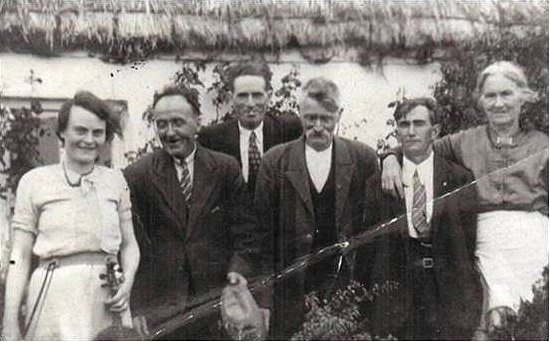
The Doyle family home in Ballymakea, 1940. Like most country cottages of its day,
it had a thatched roof. Michael is not pictured, but his sister Eileen holds a fiddle, left.
His father James Doyle is at center, and his mother Honor is at right.
Doyle played a simple German concertina all his life, preferring its tone - that of the old country sound - over the 'sharp' sound of an 'English' (meaning Anglo) instrument. He was recorded in the 1960s by the late Clare musician John Joe Healy, whose widow gave the tapes to Jim Carroll; those field recordings are now accessible at the Irish Traditional Music Archive in Dublin. There are only a small handful of these recordings, of seven reels and two hornpipes. Three are included here.
The Mount Phoebus Hunt, a hornpipe in the key of G, is shown in the adjacent transcription. Doyle played the tune singly in a cross-row style on his two-row instrument. Although the first part of the tune is played entirely on the C row of his C/G concertina, the second part alternates back and forth between the C and G rows. In general, the higher parts are played on the G row and the lower parts on the C row. This ability to cross the rows is similar to the row-changing in the two-row octave style. Doyle's ornamentation primarily includes triplets as well as brief runs of octave notes. He played frequently with fiddle players, and probably for that reason most of his recordings are in the key of G.

The Mt Phoebus Hunt, as played by Michael Doyle. Transcribed for the C/G Anglo by Dan Worrall
An Untitled reel is played very quickly and with great drive, in the key of G and all on the G row. The A part is mostly played singly, with octaves placed for emphasis on the long notes at ends of phrases. The B part is largely played in octaves, not unlike Mrs Crotty's approach in The Wind That Shakes the Barley.
A second Untitled reel is also played in the key of G, all singly, and almost all on the G row. The tempo is very quick, indeed amazing for a German concertina.
Because there are so few tunes in his recorded repertoire, it is not possible to say much about the breadth of it. His sister Eileen Doyle Johnson, however, played a wide variety of tunes on her accordion in later years, including many waltzes and polkas in addition to reels, hornpipes and jigs.![]() 20
20
Micho's father had bought him a Clarke's tin whistle when he was eleven years old. All three brothers learned much of their music from a neighbour, Patrick Flanagan. Patrick was a concertina player. To begin with, he simply taught Micho which fingers to lift to play a scale on the tin whistle. After that Micho was more or less left to his own devices and continued learning by ear. He returned to Patrick Flanagan later on to polish his tunes and add to his store.![]() 21
21
It has been noted that Micho Russell's unique style on the whistle had much to do with his learning tunes from the concertina playing of Flanagan. Flanagan was a generation older than the Russell brothers. Doolin at that time was a poor village in a backwater of west Clare, where scenery abounded but money was scarce; house dance and house sessions were major forms of recreation, and folk customs were strong.
Flanagan was recorded by Shaun Jordan of Lisdoonvarna County Clare, in about 1960, when Flanagan was 75 years of age The recording included five reels and two jigs, and was made in a country house session in Doolin, in a house belonging to a neighbor of Flanagan's named Griffith. Jordan remembers that it was difficult to record Flanagan, as he was a bit uncomfortable with being recorded, regardless of his evident skills on his instrument. In a very brief interview, the soft-spoken Flanagan recalls learning the German concertina as a boy, when concertina playing was very common in his village.
Flanagan played a two row C/G German concertina. He played reels singly in a cross row manner, keeping most of the melody on the right hand and leaving the left mostly with some simple bass drones. Unfortunately, the microphone in this field recording was placed near the left side of the instrument, so the drones tend to overpower the melody; such would not be the case in a live session. The first of the following two Untitled reels is played in the key of C, starting on the C row in the A part but moving to the G row as the tune rises in pitch in the B part. The second reel in this melody is played in the key of D minor, mostly on the C row.
The Concertina Reel is played in an old style - all on the C row, including the higher pitched parts. For high parts, Flanagan moves his right hand up one position so that his pinkie is over the right-most button so that the high triplets flow effortlessly.
In the following two Untitled reel, Flanagan is accompanied by a lilter, much to his pleasure. In most of the field recording, his discomfort with being a solo 'performer' is evident, but when the lilter accompanies him his playing reaches a higher level. It is clear that this impromptu recording session did not capture a master concertina player at his best, but it is all we have today of his playing.
In general, Barry sets a very rapid pace for the reels in this recording, regardless of whether playing solo or with other musicians. In most reels he plays singly on his Anglo concertina, which is an appropriate choice for the tempo (and for playing in G and D with fiddles and flutes). On a few tunes, however, he plays in octaves. All of the tunes and their settings in this recording are ones that are familiar to most Irish musicians today, especially those in west Clare.
The Heathery Breeze is a standard setting not very different than that of Packie Russell. It is played in the key of G on a CG concertina, all on the G row (note: the field tape recordings of Barry are all one and one half semitones sharp).
Sporting Nell is a variant of that reel recorded not many years ago by the late concertina player Tommy McCarthy. The tune is in the key of D minor. Although McCarthy played it on the G row, Barry plays it entirely on the C row, at times in octaves, at other times singly. There are two separate recordings of this piece given here, one solo and one with two unknown musicians on fiddle and whistle. This sort of group session playing became more and more common in the era of the céilí bands.
An Untitled reel is played in the key of G, all on the G row, and makes extensive use of octaves.
A second Untitled reel is in the key of C, and here too Barry makes extensive use of octaves. It is played entirely on the C row.
Sally Gardens is played with a group of musicians. It is a familiar setting, played in the key of G. Barry plays it nearly entirely on the G row, resorting to the C row in the A part for an E that he wished to play on the push rather than the pull. He is joined by unknown musicians on the fiddle and spoons.
2. Gearóid Ó hAllmhuráin, PhD thesis (1990), p.175.
3. Ibid, p.109.
4. Ibid., p.100.
5. Ibid., p.168.
6. That CD is entitled Madam, I'd Like to Be Tossin' Your Hay.
7. Note: Riobard's brother Sean has here edited the list of instruments used by the family.
8. Riobard O'Dwyer, The olden days, an unpublished posting on RootsWeb, January 1, 2009.
9. Mary O'Sullivan, as quoted in Larry Lynch, 1991, p.147.
10. Gearóid Ó hAllmhuráin, PhD thesis (1990), pp.166-168.
11. Muiris O Rócháin, 1975, in the liner notes to Clare Concertinas, Free Reed CD FCLAR 02.
12. Joseph Green, 1995, An interview with Chris Droney: in Concertina and Squeezebox, Ithaca, New York, No. 32, p.39.
13. Joseph Green, 1995, p.40-41.
14. Joseph Green, 1995, p.39.
15. Joseph Green, 1995, p.41.
16. Gearóid Ó hAllmhuráin, 1986, p.320.
17. Gearóid Ó hAllmhuráin, 1993, "From Hughdie's to the Latin Quarter: A Tribute to Clare Concertina Player Paddy Murphy," Treoir vol. 25, no. 2 (1993), pp. 40-44. This story was quoted by Nicholas Carolan, see Note 104, p.56-57, from which I excerpted my own account.
18. The Westmeath Hunt: William Mullaly, The First Irish Concertina Player on Record: CD, Irish Traditional Music Archive, Dublin, 2011.
19. Harry Bradshaw, Biography of William Mullaly, in The Westmeath Hunt: William Mullaly, The First Irish Concertina Player on Record: CD, Irish Traditonal Music Archive, Dublin, 2011.
20. Eileen Doyle Johnson was the author's grand-aunt, and Michael Doyle his grand-uncle.
21. Anonymous, 2011, Russell Brothers, Micho, Pakie and Gussie: in Clare People, Clare County Library Website, www.clarelibrary.com
| NEXT |